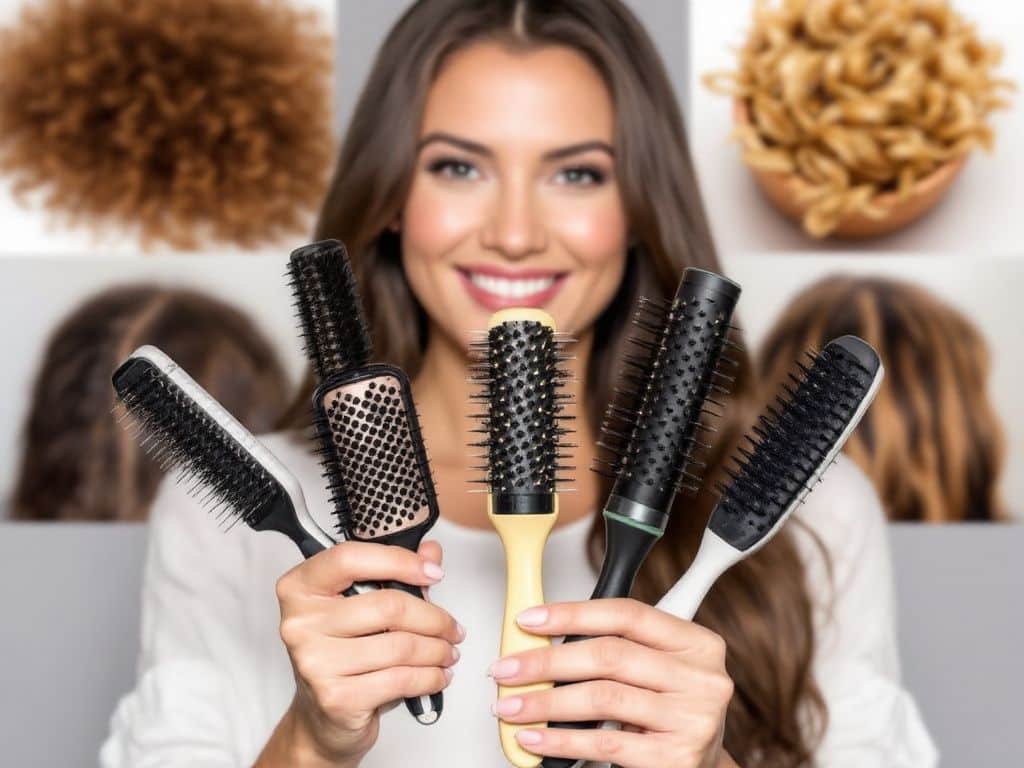
In a world where personal grooming tools are copiously arrayed, choosing the appropriate hairbrush can sometimes feel as daunting as navigating a labyrinth. Understanding why a brush designed for a specific hair type might not work for every individual encompasses aspects of materials science, hair anatomy, and practicality in grooming. Welcome to a guide that bridges the gap between the complex landscape of hair tools and your everyday needs.
Unveiling the Science Behind Hair Tools 🧠
The science behind hair tools, particularly brushes, draws largely from understanding hair physiology and the properties of materials used in brush construction. While selecting brushes might seem straightforward, various intricate variables contribute to their effectiveness—or lack thereof—with certain hair types.
Understanding Hair Anatomy
At its core, human hair varies significantly in structure, thickness, and length—all contributing factors in determining how well a brush works on different hair types. There are three main layers: the cuticle (outer layer), the cortex (middle layer), and the medulla (innermost layer).
- Cuticle: This is made up of overlapping scale-like cells and offers a protective barrier. For brushes, particularly with higher friction, poorly designed bristles can damage the cuticle, leading to breakage.
- Cortex: Responsible for hair’s strength, color, and texture. Brushes need to be gentle to avoid causing stress that could impact this crucial middle layer.
- Medulla: More common in thicker hair, this central core supports hair’s flexibility but is generally influenced less by brushing.
Brush Material Matters

The materials from which brushes are constructed profoundly affect their compatibility with different hair types. Here’s a comprehensive evaluation:
- Bristle Type: Natural vs. Synthetic
- Natural Bristles*: Ideal for fine to medium hair to distribute natural oils without static, but can often struggle with thick or curly textures.
- Synthetic Bristles*: Typically made from nylon, these are more proficient with detangling thicker hair due to their durable composition but may become abrasive on finer hair.
- Handle Material: Plastic vs. Wood
- Wood*: Offers a more sustainable choice and provides a comfortable grip. More often chosen for high-quality natural bristle brushes.
- Plastic*: Generally offers durability and is lightweight, making them affordable but sometimes less environmentally friendly.
- Brush Shape and Structure:
- Paddle Brushes*: Excellent for straightening and smoothing longer hair.
- Vent Brushes*: Ideal for quick drying, leveraging air vents to enhance flow in layered cuts.
Tool Effectiveness: Backed by Research 📊
Various studies have delved into the relationship between brush design and hair health, offering empirical insights. In a detailed study published in the “Journal of Material Science”, comparisons between natural and synthetic bristles highlighted that synthetic tended to cause more friction regardless of hair type.
Case Study: Evaluating Brush Choice Impact 💡
Paul Mitchell, an authoritative brand in hairstyling, once conducted a detailed case study comparing different brush types across multiple hair types. It revealed that the key to minimizing breakage and enhancing shine lies predominantly in brushing techniques combined with the right brush material.

- For Curly Hair: Opting for a wide-tooth comb or a natural bristle brush reduced breakage by over 50% compared to synthetic materials, which often snag more prominently in coils.
- For Fine Hair: The gentle distribution of natural oils by natural bristles resonates well, reducing damage significantly in comparison to harder, more rigid synthetic bristles.
Standards and Best Practices from the Field
The National Cosmetology Association recommends selecting brushes based not solely on hair type but also on daily hair requirements such as normal styling vs. intricate detangling.
- Regular Use: A paddle brush with boar bristles is often deemed most suitable for daily grooming, especially for straight to wavy hair.
- Specialized Detangling: Opt for designs specially made for wet hair if you need thorough detangling—particularly effective for minimizing stress along the hair shaft.
Technical Walkthroughs: How to Select the Right Brush 🛠️
Determining Hair Type
Understanding whether your hair is fine, medium, coarse, straight, wavy, or curly is the first step. Here’s how to correlate that information to a brush:

- Fine/Wavy Hair: Natural bristle brush or a soft paddle brush, promoting low-friction grooming.
- Thick/Curly Hair: A wide-tooth comb or synthetic brush, benefiting from enhanced detangling ability without added friction.
- Textured Hair: Specialized brushes, often paddle-shaped, specifically designed to manage unique curls and coils effectively.
Actionable Tips for Brush Maintenance
To extract the most value and longevity from your brush:
- Clean regularly (every 2 weeks) by removing hair that accumulates in bristles to reduce yeast and bacteria build-up.
- Use a mix of baking soda and water to gently scrub and rinse plastic parts; allow it to air dry completely to hinder mildew or odor.
Real-World Practicality and Application 📈
Consider an individual with dual hair types—extremely curly shafts interspersed with straighter segments. For them, investing in both a wide-tooth comb and a `natural boar bristle brush` provides versatility and preserves hair health effectively across different hair states.
Conclusion: Partnering Science with Practicality
Purchasing decisions around hair tools are not just about instruments; they’re decisions that nurture personal confidence and style. When you integrate an analytical approach, considering both scientific findings and expert insights, you’re equipped to make educated decisions that improve not just the condition of your hair, but also your overall grooming experience.
In the intricate web of hair tools, mastering the best brush choices not only resolves grooming challenges but extends the vitality and texture of your hair to inspiring new heights. Equipped with this holistic, data-enriched knowledge, you breathe new life into age-old rituals, enhancing both your daily personal routine and broader appreciation of the science behind personal care instruments.🖌️
Frequently Asked Questions
What are the benefits of using a hair mask in my hair care routine?
Using a hair mask can provide several benefits, including hydration, smoothing, strengthening, curl definition, heat protection, and damage repair. Hair masks infuse the hair with moisture, help coat the hair shaft to seal split ends, reduce breakage, and protect the hair from heat styling and environmental damage[1][4].
What ingredients should I look for in a hair mask?
Effective hair masks often include ingredients such as coconut oil, argan oil, shea butter, honey, avocado oil, green tea, and coconut water. These ingredients provide nourishment, moisturize, and protect the hair, offering benefits like softening, moisturizing, and protecting against damage[2][5].
How often should I use a hair mask in my routine?
You should use a hair mask whenever your hair feels dry, unmanageable, or in need of intense hydration. This can vary depending on your hair type and needs, but generally, using a hair mask once or twice a week can help maintain healthy and moisturized hair[1][4].
How do I apply a hair mask for the best results?
To apply a hair mask effectively, shampoo your hair first, then apply the mask, focusing especially on the ends where hair tends to be the most damaged. Leave the mask on for anywhere from 10 minutes to overnight, depending on the type of mask and your hair’s needs[1][4].
References


Leave a Reply